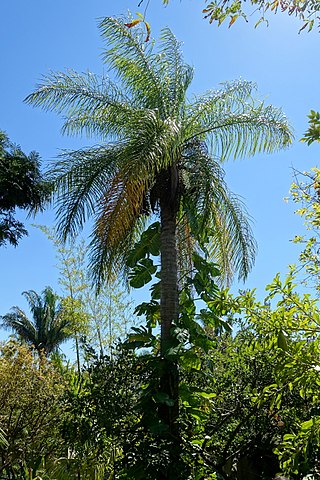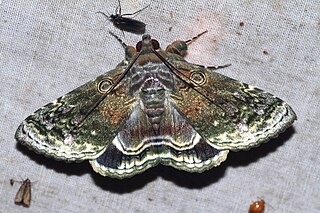Related Research Articles

Jewellery consists of decorative items worn for personal adornment such as brooches, rings, necklaces, earrings, pendants, bracelets, and cufflinks. Jewellery may be attached to the body or the clothes. From a western perspective, the term is restricted to durable ornaments, excluding flowers for example. For many centuries metal such as gold often combined with gemstones, has been the normal material for jewellery, but other materials such as glass, shells and other plant materials may be used.

Brown is a color. It can be considered a composite color, but it is mainly a darker shade of orange. In the CMYK color model used in printing and painting, brown is usually made by combining the colors orange and black.

The coconut tree is a member of the palm tree family (Arecaceae) and the only living species of the genus Cocos. The term "coconut" can refer to the whole coconut palm, the seed, or the fruit, which botanically is a drupe, not a nut. They are ubiquitous in coastal tropical regions and are a cultural icon of the tropics.

Jaggery is a traditional non-centrifugal cane sugar consumed in the Indian subcontinent, Southeast Asia, North America, Central America, Brazil and Africa. It is a concentrated product of cane juice and often date or palm sap without separation of the molasses and crystals, and can vary from golden brown to dark brown in colour. It contains up to 50% sucrose, up to 20% invert sugars, and up to 20% moisture, with the remainder made up of other insoluble matter, such as wood ash, proteins, and bagasse fibres. Jaggery is very similar to muscovado, an important sweetener in Portuguese, British and French cuisine. The Kenyan Sukari ngutu/nguru has no fibre; it is dark and is made from sugarcane and also sometimes extracted from palm tree.
Body piercing jewelry is jewelry manufactured specifically for use in body piercing. The jewelry involved in the art of body piercing comes in a wide variety of shapes and sizes in order to best fit the pierced site. Jewelry may be worn for fashion, cultural tradition, religious beliefs, personal symbolism, and many other reasons.

Almond Joy is a candy bar manufactured by The Hershey Company, consisting of sweetened, shredded coconut topped with whole almonds and covered in milk chocolate. The company also produces Mounds bars, a similar confection without nuts, coated in dark chocolate.

A chemically pure and structurally perfect diamond is perfectly transparent with no hue, or color. However, in reality almost no gem-sized natural diamonds are absolutely perfect. The color of a diamond may be affected by chemical impurities and/or structural defects in the crystal lattice. Depending on the hue and intensity of a diamond's coloration, a diamond's color can either detract from or enhance its value. For example, most white diamonds are discounted in price when more yellow hue is detectable, while intense pink diamonds or blue diamonds can be dramatically more valuable. Of all colored diamonds, red diamonds are the rarest. The Aurora Pyramid of Hope displays a spectacular array of naturally colored diamonds, including red diamonds.

Acrocomia aculeata is a species of palm native to the Neotropics.

Phytelephas is a genus containing six known species of dioecious palms, occurring from southern Panama along the Andes to Ecuador, Bolivia, Colombia, northwestern Brazil, and Peru. They are commonly known as ivory palms, ivory-nut palms or tagua palms ; the scientific name Phytelephas means "plant ivory" or more literally, "plant elephant". This and the first two of the common names refer to the very hard white endosperm of their seeds, which resembles elephant ivory.

Biological pigments, also known simply as pigments or biochromes, are substances produced by living organisms that have a color resulting from selective color absorption. Biological pigments include plant pigments and flower pigments. Many biological structures, such as skin, eyes, feathers, fur and hair contain pigments such as melanin in specialized cells called chromatophores. In some species, pigments accrue over very long periods during an individual's lifespan.

Ammolite is an opal-like organic gemstone found primarily along the eastern slopes of the Rocky Mountains of North America and the Foothills of Alberta. It is made of the fossilized shells of ammonites, which in turn are composed primarily of aragonite, the same mineral contained in nacre, with a microstructure inherited from the shell. It is one of few biogenic gemstones; others include amber and pearl.
Dwarf coconut is a range of varieties of coconut palm. The use of the word “dwarf” here does not refer to the tree's size, as it can reach heights of 50–100 feet which is certainly not a dwarf. Instead, the dwarf designation refers to the size at which it will begin to produce the coveted or harvestable coconut.

Sanoor is a village in the southern state of Karnataka, India. During the British Raj, the village was headed by the Patels (Patler). Since independence, it has been administered by a mandala Panchayati raj. The nearest court is in Karkala, 5 kilometres (3.1 mi) from the village center. Sanoor has several primary schools and a government pre-university college. The Tulu language is widely spoken; other languages spoken in the village are Konkani and Kannada. The Bunt and Billava were early ethnic communities, with the Marathi, Konkani and Brahmins arriving later. With Portuguese settlement, villagers converted to Catholicism. Local Muslims belong to the Moplah community, are known as Beary and speak the Beary dialect of Tulu. The Beary, living in the region for over a thousand years, may be descended from Arab traders.

Aceria guerreronis, the coconut mite, is an eriophyid mite which infests coconut plantations. It is economically devastating, and can destroy up to 60% of coconut production. The immature nuts are infested and injured by mites feeding in the portion covered by the perianth of the immature nut.

Croatian national costume, also called as Croatian traditional clothing or Croatian dress, refers to the traditional clothing worn by Croats living in Croatia, Bosnia and Herzegovina, Serbia, with smaller communities in Hungary, Austria, Montenegro, and Romania. Since today Croats wear Western-style clothing on a daily basis, the national costumes are most often worn with connection to special events and celebrations, mostly at ethnic festivals, religious holidays, weddings, and by dancing groups who dance the traditional Croatian kolo, or circle dance.
Shades of brown can be produced by combining red, yellow, and black pigments, or by a combination of orange and black—illustrated in the color box. The RGB color model, that generates all colors on computer and television screens, makes brown by combining red and green light at different intensities. Brown color names are often imprecise, and some shades, such as beige, can refer to lighter rather than darker shades of yellow and red. Such colors are less saturated than colors perceived to be orange. Browns are usually described as light or dark, reddish, yellowish, or gray-brown. There are no standardized names for shades of brown; the same shade may have different names on different color lists, and sometimes one name can refer to several very different colors. The X11 color list of web colors has seventeen different shades of brown, but the complete list of browns is much longer.

Cyclodes omma is a moth of the family Erebidae. It is found from the Oriental tropics to the Moluccas, including India, Nepal, Vietnam, Cambodia, Myanmar, Thailand, Malaysia, Java, Bali, Sumatra, Timor, Sri Lanka, Flores, Sulawesi, the Philippines, China and Taiwan.
A domesticated quail is a domestic form of the quail, a collective name which refers to a group of several small species of fowl. Thousands of years of breeding and domestication have guided the bird's evolution. Humans domesticated quails for meat and egg production; additionally, quails can be kept as pets. Domesticated quails are commonly kept in long wire cages and are fed game bird feed. The most common domesticated type is the Coturnix quail. Quails live on the ground, and rarely fly unless forced to do so.

Phytelephas macrocarpa is a single-stemmed, unarmed, reclining or erect palm from the extreme northern coastal regions of South America, growing to some 12 m tall. It has been introduced and cultivated in tropical regions all over the world. The trunk is about 30 cm across, with prominent leaf scars. The crown is made up of about 30 plume-like leaves or fronds, each about 8 m long, dead leaves being persistent. It is one of some 7 species of palm in the genus Phytelephas, all of which have been exploited for vegetable ivory or tagua from the seed or corozo nut. The closely related Ammandra decasperma from Colombia, and Aphandra natalia from Ecuador, are also sources of vegetable ivory, but of inferior quality and therefore not commercially significant. 'Phytelephas macrocarpa' translates to ‘elephant plant’ with 'large fruit', the endosperm of the nut having the texture of elephant ivory, and consisting of large, thick-walled cells of two long-chain polysaccharides, mannan A and B.

Canarium indicum, known as galip nut, is a mainly dioecious tree native in eastern Melanesia. It is usually found in rainforests, secondary forests, old garden areas, around villages and settlements. It is also used as a shade tree, as a windbreak and in agroforestry. Canarium is important in the world food system as it can be used as a food and timber source, in traditional medicine, intercropping and agroforestry.
References
- ↑ Wright, Kristina Dziedzic. (2008). Cleverest of the clever: coconut craftsmen in Lamu, Kenya. The Journal of Modern Craft, 1(3), 323-343. doi : 10.2752/174967808X379416
